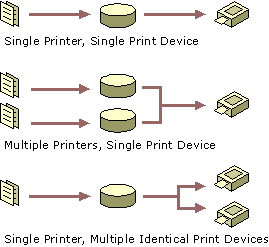Print Devices, Print Clients, Printers, and Print Servers
A print device is a hardware device used for printing. Print device resolution is measured in dots per inch (DPI). The higher the DPI, the finer the resolution.
A print client is an application on a user's computer that submits print jobs to a print device. Print jobs are source code that contain both data and commands for print processing. Print jobs are classified into data types based on the modifications that the print server must make to the job to print correctly.
The printer is the software interface between a print device and the print clients. It is sometimes called a logical printer and typically resides on the print server for remote printing. For local printing or print jobs redirected to a remote print device, the printer software is located on the print client.
The printer software specifies the print device's interface with the operating system and is stored with a unique printer name in the Printers folder. It includes the printer driver. Printer drivers are programs that enable applications to communicate properly with specific print devices.
The printer software specifies the port by which a document reaches the print device. A printer port is the software interface through which a computer communicates with the print device by means of a locally attached interface, such as LPT, COM, or universal serial bus (USB) or by means of a network-attached device such as HP JetDirect, Intel NetPort, or Extended Systems Print Server using a network transport protocol like TCP/IP or Data Link Control (DLC).
Multiple printers can be defined for a single print device, allowing clients to use it in different ways. One user might want the device to be widely available; another might want to restrict it; one might want double-sided printing; another might want single-sided printing only. Conversely, as shown in Figure 4.1, a single set of printer software can access multiple print devices. This is called printer pooling.

Enlarge figure
Figure 4.1 Printer Software-Hardware Relationships
A print server is a computer that manages a queue of print jobs for a shared print device. Computers running Windows 2000 Server or Windows 2000 Professional can function as a print server. However, Windows 2000 Professional limits concurrent connections to 10. If more than 10 clients need to connect to the print server simultaneously, Windows 2000 Server is the better solution.
A print server that is running on Windows 2000 can process remote printing over various network protocols, such as NWLink, TCP/IP, or AppleTalk. The Transmission Control Protocol/Internet Protocol (TCP/IP) is required for Internet communications and is installed with Windows 2000 Server.
The preferred port monitor in Windows 2000 is the Standard TCP/IP Port Monitor (SPM), which uses TCP/IP as the transport protocol. SNMP is used to configure and monitor the printer ports. In addition to SPM, Internet printing adds an hypertext transport protocol (HTTP) port monitor. All other port monitors that were included with Windows NT 4.0 are also present.
© 1985-2000 Microsoft Corporation. All rights reserved.
EAN: N/A
Pages: 404